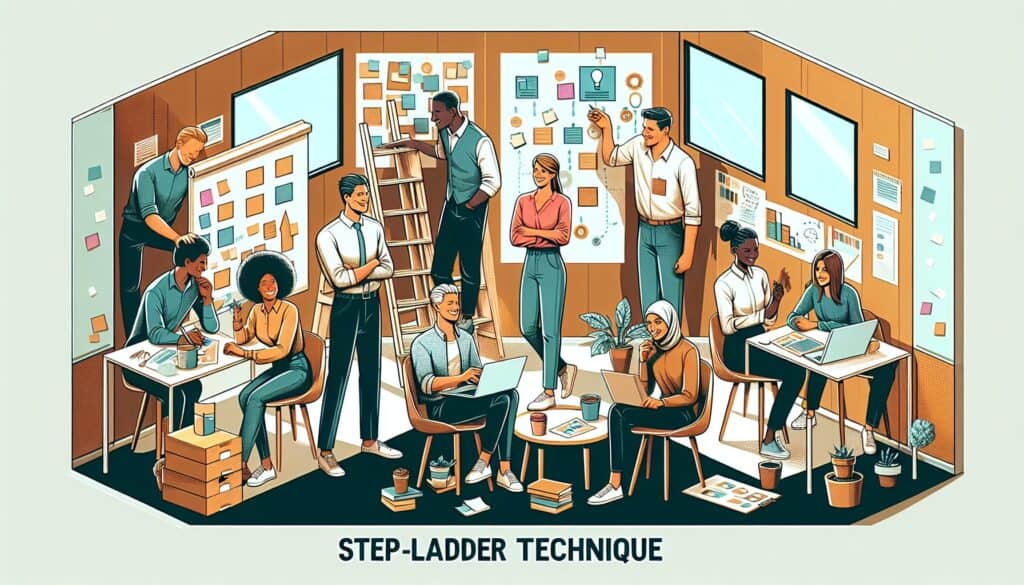一种结构化的小组决策或集思广益技术,旨在确保所有成员在受小组影响之前都能提出自己的独立想法。
- 方法: 客户与营销, 经济学, 产品设计
阶梯技术

阶梯技术
- 集思广益, 创造力, 跨职能协作, 设计思维, 创新, 解决问题的技巧, 团队合作, 以使用者為中心的設計, 价值主张
目标
如何使用
- 两名核心成员讨论问题。然后,在听取初步讨论之前,其他成员逐一提出自己的想法。每位新成员发言后,小组讨论迄今为止提出的所有想法。
优点
- 鼓励所有成员独立思考;有助于防止过早顺从或被更有主见的人支配;在某些情况下,可做出更高质量的决策。
缺点
- 可能比较耗时,尤其是对人数较多的小组而言;需要仔细管理输入和讨论过程;可能不适合非常紧急的决策。
类别
- 构思, 解决问题
最适合:
- 改进小组决策,确保所有成员都先提出自己的想法,然后再受小组成员的影响。
The Step-Ladder Technique is highly applicable in various sectors such as technology, healthcare, and automotive design, where teams are often tasked with solving intricate problems that require diverse perspectives for effective solutions. This methodology is particularly useful during the ideation phase of a project when the team is brainstorming solutions for new products or improvements. Typically, the process begins with two core members sharing their thoughts on the problem at hand, creating a baseline of ideas that new team members can build upon when they present their contributions one by one. This approach can involve engineers, designers, product managers, or even stakeholders who might impact the final decision. Each new member’s contribution is discussed in the context of previous suggestions, avoiding premature convergence on a single idea and ensuring that each voice is heard. This method promotes independent thought and minimizes the risk of groupthink, which is often prevalent in collaborative environments, especially when a few dominant personalities may sway the discussion. As such, companies using this technique often report enhanced creativity and innovation due to the varied viewpoints being considered. In settings where high-stakes decisions are required, such as clinical environments or product safety assessments, the Step-Ladder Technique can ensure that all sides of an issue are deliberated and that the final decision is informed by a comprehensive understanding of the problem, leading to more robust outcomes that reflect a wider range of experiences and expertise.
该方法的关键步骤
- Two core members discuss the problem and generate initial ideas.
- Each additional member presents their ideas one at a time.
- After each new member presents, facilitate a discussion of all ideas shared so far.
- Encourage refinement and evaluation of ideas through further discussion.
- Continue this process until all members have contributed their ideas.
- Conclude the session with a comprehensive discussion incorporating all ideas shared.
专业提示
- Integrate role rotation within the group to enhance diverse viewpoints and counteract any single member's bias during discussions.
- Utilize time-boxing for each member's idea presentation to maintain engagement and encourage concise expressions of thoughts.
- Incorporate anonymous feedback mechanisms after discussions to assess satisfaction with solutions and further uncover any overlooked insights.
历史背景
1960
1980
1983
1990
1995
2000
2010
1950
1980
1980
1986
1994
1995
2000
(如果日期不详或不相关,例如 "流体力学",则对其显著出现的时间作了四舍五入的估计)。














相关文章
肌肉骨骼不适调查表
多变量测试(MVT)
多元回归分析
动作捕捉系统
MoSCoW 方法
情绪中值测试